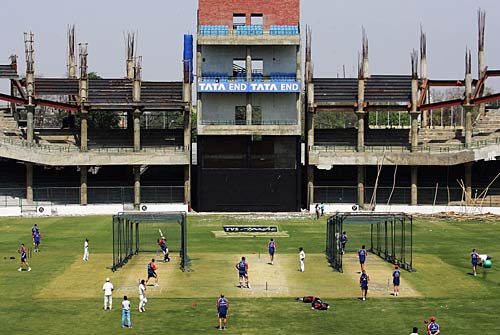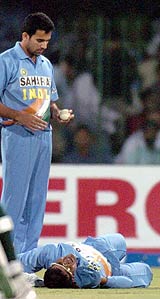How to spend a billion
A few suggestions about how the BCCI can spend its money
Ashok Malik
03-Apr-2006
Indian cricket is a funny animal. It has the instincts of a business enterprise when it comes to maximising revenue. In terms of the way it is run and what it offers its stakeholders, however, it is about as professional and efficient as a government hospital in a district town. In the long run, this mismatch is not sustainable.
This season, a collection of overwhelming sponsorship deals has made the Board of Control for Cricket in India (BCCI) richer than any cricket body anywhere and ever. So now what will the board do with its fat bank balance?
It has committed itself to enhancing prize money in domestic competitions, paying higher fees to international and first-class players, and introducing a pension fund. Beyond these baubles, it has no spending plan. Here are four suggestions for it to ponder.
|
|

|
India is currently in the middle of a wrenching debate on the state of its airports. Private airlines are adding more and more flights, but the airports remain stuck in the 1970s, seeing the passenger as an inconvenient interruption and clean toilets as a luxury.
The crisis with India's cricket stadia is very similar. For the ordinary ticket-buying spectator, the experience of watching a match is, frankly, hellish. A modern stadium with turnstiles, numbered seats, polite ushers and stewards, appropriate necessities in terms of toilets and food access is a dream.
The problem is many of the stadia - Kanpur and Indore are random examples - are owned by the government and leased out to the local cricket authority, the BCCI's state-level affiliate, on sufferance, almost as an act of patronage. A stadium that the BCCI - or its constituent state unit - doesn't own becomes, in effect, an orphan. The BCCI needs to deploy some of its money into a seed capital fund to buy off existing stadia from the government and take charge of its own properties. That aside, in smaller cities or suburban centres at the periphery of big cities, it could go straight to the real estate market and build model greenfield stadia.
As the examples of Mohali and Delhi - where the Ferozshah Kotla is finally beginning to resemble the showpiece stadium it should be - bear out, local corporate houses will gladly share the BCCI's burden. Selling off boxes and getting particular gates or stands named for or otherwise sponsored by big business is hardly rocket science.
Cricket, in any case, is an overheated market, with too much money chasing too few worthwhile investment options. Why not divert some of the attention towards infrastructure? Each stadium can be defined as a separate profit centre, building into itself facilities that will be used to generate revenue in fallow months.
As the planet's most passionate cricket country, India should have the world's best stadia. That is the bottomline. The BCCI has the money; it has to find the will to deliver.
Spreading the gospel
The Maharajkumar of Vizianagram, India's most undeserving Test captain, had some rare moments of insight. One of his inspired suggestions was that India should look for fast bowlers not in big cities but in smaller towns, even rural settings, such as, for instance, the agricultural belts of the old Punjab.
The Maharajkumar of Vizianagram, India's most undeserving Test captain, had some rare moments of insight. One of his inspired suggestions was that India should look for fast bowlers not in big cities but in smaller towns, even rural settings, such as, for instance, the agricultural belts of the old Punjab.
In a sense, the emergence of Munaf Patel validates this idea. India's newest fast bowling hope comes from rural Bharuch, a rain-deprived, hope-scarce region in Gujarat.
Cricket today is more than just a sport in India. It may be an indulgence for the elite. For the broader middle and lower middle classes, however, it is an aspirational vehicle, a route to social mobility, replacing, for example, hockey as the game to play and follow in rural Punjab.
There is untapped potential and latent energy that needs a channel. India's engagement with cricket needs to be deepened and institutionalised. Again Punjab and its district cricket network may be instructive.
In essence, the BCCI needs to put in place a proper outfield, quality nets, and a set of trained - perhaps BCCI-accredited - and salaried coaches to be available round the year in each district HQ. In bigger districts, which have more than one large town, there could be two or three such arrangements.
Given that India has about 600 districts, we are not talking very large numbers. A pyramid structure - with genuine talent scouts rather than former cricketers sent out on desultory junkets - will need to link these grassroots units and monitor their progress and needs. These district-level BCCI bridgeheads can become the pivot around which to build a strong schools cricket programme. This process will throw up new talent; it will also expand the social base of Indian cricket and help the BCCI "give back" to the society it feeds on. To use a fashionable expression, it is part of the board's corporate social responsibility.
It would be easy for the BCCI to pretend that such an evangelical mission lies in the domain of the state associations and that it has no role to play. This is nonsense. Each district has to be integrated into an all-India matrix. Visiting faculty - say, specialist fitness trainers or spin bowlers - will need to drop in on districts regularly. This will require centralised coordination.
When the BCCI gets down to hiring its professional managers and paying them corporate-level salaries (all of which it says it will do once Tata Consultancy Services has drawn up a blueprint for it), it should set aside money and human resources for a centrally managed (or at least supervised) districts cricket programme.
|
|

|
Every time an Indian cricketer has a semi-serious injury, he is flown off to Britain or Australia or South Africa for treatment. This has become a regular feature, endearing the BCCI to its travel agents but leaving ordinary cricket fans wondering why - in this age of "medial tourism", when the world comes to India for treatment - sports medicine is deemed so inadequate here.
The BCCI needs to invest in a flagship, national-level sports medicine centre, which will have a permanent nucleus of expert staff as well as educational facilities for sports trainers and physiotherapists. It can run courses - say four times a year - for physios and those responsible for a cricket team's fitness and well-being. It can invite specialists from other countries. It can undertake research on how to nurture, say, fast bowlers in Indian conditions, given the quantum of cricket being played these days.
This idea is not new. It is understood that Andrew Leipus had proposed something similar to Jagmohan Dalmiya when he was the BCCI's president. Hopefully the sports medicine centre will find a new patron.
That heritage thing
Indian cricket, it is often lamented, has no sense of history. Other than a few mad buffs, scarcely anybody attempts to link India's ascension to cricket power and the prodigious heritage that the sport is blessed with. Certainly, the BCCI couldn't care less.
Indian cricket, it is often lamented, has no sense of history. Other than a few mad buffs, scarcely anybody attempts to link India's ascension to cricket power and the prodigious heritage that the sport is blessed with. Certainly, the BCCI couldn't care less.
In the 18th century America's founding fathers saw their nation as an inheritor to the civilisational legacy of the Western world. They built cities and institutions, invented mythologies, and created literature to sustain that continuity.
As cricket's new torchbearer, India must be similarly alive to its obligations. The BCCI needs to build an Indian Cricket Museum - actually it could do with four such museums, given the geographical spread of India, but even one will do for a start. The museum has to be conceived with sensitivity and enlightenment. It must have a curator who is knowledgeable about cricket's past - not an unctuous BCCI hanger-on. It must record the history of cricket in India - its sporting and social aspects, its role in shaping this country, and India's greater role in reshaping a leisurely English pastime. The museum will need a corpus to acquire artifacts and memorabilia, buy them where necessary. It would help if the curator were alive to alternative fund-raising methods and not wholly dependent on grants from the BCCI.
As it grows, the museum can become India's - and the BCCI's - statement that it does not see cricket as just a money-making racket and a proxy for nationalism. Like the other suggestions in this article, it perhaps calls for a new cricket sensibility.
Is the BCCI up to it?
Ashok Malik is a journalist based in Delhi